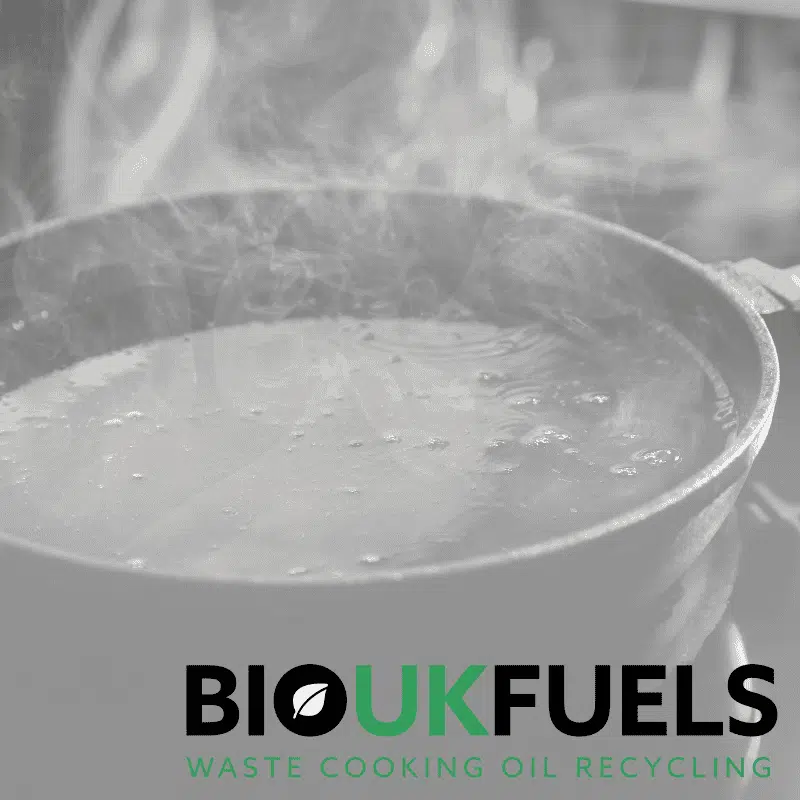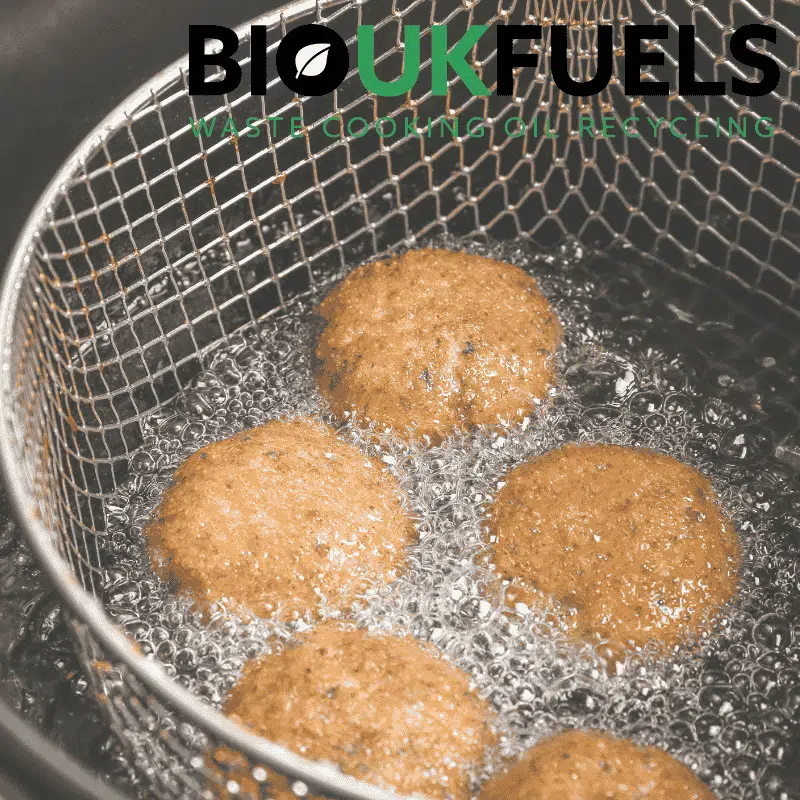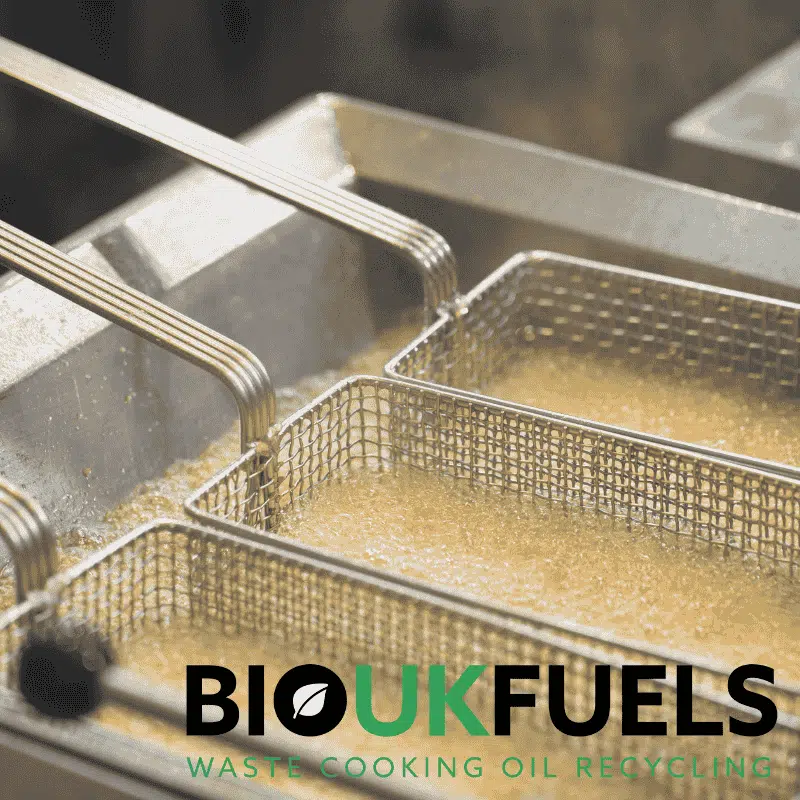

Choosing the right cooking oil based on its smoke point is crucial for both flavour and health. The smoke point, which refers to the temperature at which oil begins to break down and release smoke, plays a significant role in determining the best oil for high-heat cooking methods like deep frying and roasting
Oils with higher smoke points maintain their nutritional properties and prevent the release of harmful compounds during cooking, making them ideal for high-heat applications like frying. Once these oils are used, proper disposal is crucial to avoid environmental harm.
Recycling waste cooking oil not only supports sustainability but also allows businesses to turn waste into a valuable resource. So, which oil has the highest smoke point, and why does it matter? Let’s dive into the science and practicalities behind this key cooking factor.
For more on responsible oil recycling, contact Bio UK Fuels


Understanding Smoke Point in Cooking Oils
Understanding the smoke point in cooking oils is essential for both professional chefs and home cooks, as it directly impacts the flavour profile, nutritional quality, and health benefits of the dishes prepared.
The oil smoke point is defined as the temperature at which an oil begins to smoke and decompose, releasing harmful fumes and potentially carcinogenic compounds.
This characteristic varies significantly among different types of cooking oils, including both refined and unrefined oils, and influences not only food preparation methods but also the overall quality of the culinary experience.
What is the Highest Smoke Point for Cooking Oils?
Identifying the highest smoke point for cooking oils is essential for selecting the most appropriate oils for various culinary techniques. Oils with a higher smoke point, such as refined oils, are particularly suited for high-temperature cooking methods, including frying and sautéing, as they remain stable and do not degrade into harmful compounds during the cooking process.
Different oils, including avocado oil and rapeseed oil, exhibit varying smoke points; therefore, it is imperative to consult a comprehensive smoke point chart to make informed cooking decisions.
Why is Smoke Point Important in Cooking?
The smoke point of cooking oils is of significant importance in culinary practices, as it influences both the flavour and safety of food preparation.
A comprehensive understanding of how various oils behave at different temperatures is essential for individuals seeking to refine their cooking techniques, ensuring they choose the appropriate oil types for each method.
Which Cooking Oils Have the Highest Smoke Point?
Avocado oil leads with the highest smoke point of up to 270°C (518°F), making it ideal for high-temperature cooking like frying and grilling.
Oils such as avocado oil, refined coconut oil, and peanut oil are recognised for their capacity to maintain chemical stability at high temperatures, rendering them suitable choices for frying and other cooking techniques that necessitate a high smoke point.
Commonly used oils like sunflower oil (up to 230°C) and refined rapeseed oil (around 204°C) also perform well for home cooking, balancing affordability and heat stability. The table below compares the smoke points of popular oils to help you choose the best option for your culinary needs.
| Cooking Oil | Smoke Point (°C) | Best Uses |
|---|---|---|
| Avocado Oil | 270°C (518°F) | Frying, Sautéing, Grilling |
| Refined Coconut Oil | 232°C (450°F) | Baking, Deep Frying |
| Peanut Oil | 232°C (450°F) | Stir-Frying, Deep Frying |
| Almond Oil | 216°C (420°F) | Light Sautéing, Baking |
| Sunflower Oil | 220°C (428°F) | Frying, Baking |
| Soybean Oil | 232°C (450°F) | Deep Frying, Sautéing |
| Safflower Oil | 232°C (450°F) | Frying, Grilling |
| Corn Oil | 232°C (450°F) | Frying, Salad Dressings |
| Grapeseed Oil | 216°C (420°F) | Sautéing, Marinades |
| Rapeseed Oil | 204°C (400°F) | Baking, Light Frying |
Avocado Oil Smoke Point
Avocado oil is renowned for its exceptionally high smoke point, which makes it an ideal option for high-temperature cooking methods such as frying and sautéing. Along with its superior smoke point, avocado oil is rich in monounsaturated fats, contributing to its numerous health benefits and establishing it as a preferred choice among health-conscious culinary professionals. Its distinctive flavour profile enhances dishes without overpowering other ingredients.
Compared to various types of olive oils, such as extra virgin and refined, which have lower smoke points and different thermal stability, avocado oil’s high smoke point typically around 270°C (518°F) makes it more suitable for high-heat cooking.
The versatility of avocado oil allows it to adapt seamlessly to various culinary applications, ranging from grilling to baking. With a high smoke point typically around 270°C (518°F), it remains stable under heat, effectively preventing the formation of harmful compounds.
Furthermore, the oil is abundant in antioxidants and essential vitamins, such as E and K, which promote heart health and help reduce inflammation.
- Uses in marinades and dressings
- Ideal for roasting vegetables
- Perfect for high-heat baking
With its subtle, buttery taste, avocado oil imparts a delightful richness to salads, sauces, and spreads, appealing to both novice and experienced cooks seeking to enhance their meals.


Refined Coconut Oil Smoke Point
Refined coconut oil is an excellent choice for culinary professionals seeking oils with high smoke points, making it suitable for a variety of cooking applications, including frying and baking. Its neutral flavour and high oxidative stability render refined coconut oil a versatile culinary oil capable of withstanding elevated cooking temperatures without degradation. This oil is particularly favoured by individuals seeking plant-based oil alternatives that deliver exceptional performance in the kitchen.
The numerous attributes of refined coconut oil enhance its appeal. With a smoke point of approximately 232°C (450°F), it is particularly well-suited for high-heat cooking methods such as sautéing and deep-frying. In contrast, unrefined oil retains natural compounds and flavors but has a lower smoke point, making it better for low-temperature cooking and raw dishes. Culinary experts appreciate that it does not impart strong flavours, thereby allowing the inherent taste of dishes to shine through.
- Its nutritional profile includes beneficial medium-chain fatty acids, which can aid in supporting energy levels and metabolism.
- Refined coconut oil is free of trans fats, positioning it as a healthier option compared to some conventional oils.
- Furthermore, it is shelf-stable, meaning it can be stored for an extended period without refrigeration while retaining its quality over time.
For those who prioritise health alongside culinary effectiveness, incorporating refined coconut oil as a staple ingredient can provide both flavour versatility and nutritional advantages.
Almond Oil Smoke Point
Almond oil is recognised for its appealing flavour profile and relatively high smoke point, which make it suitable for various cooking methods, including light sautéing and baking. Its delightful nutty flavour enhances a wide range of dishes, while its rich composition of polyunsaturated fats contributes to numerous health benefits. Consequently, chefs often select almond oil for its versatility; it can be utilised in salad dressings, marinades, and even for frying.
Along with its culinary applications, almond oil serves as a valuable culinary enhancer. With an average smoke point of approximately 216°C (420°F), it performs effectively under high heat, comparable to other oils such as avocado or rapeseed oil. This property makes almond oil a suitable option for various cooking techniques, including:
- Light Sautéing: Ideal for quickly cooking vegetables while preserving their nutrients.
- Roasting: Provides a subtle flavour enhancement to meats and hearty vegetables.
- Salad Dressings: Drizzling almond oil over salads imparts a rich, nutty note that complements fresh leaves.
When compared to other oils, almond oil presents a distinct advantage in terms of flavour, rendering it particularly suitable for dishes where taste is of utmost importance. Incorporating almond oil into culinary practices not only elevates the quality of dishes but also promotes healthier cooking habits.
Peanut Oil Smoke Point
Peanut oil is esteemed for its high smoke point and distinctive flavour, rendering it particularly suitable for frying and Asian cuisine. This oil’s ability to maintain stability at elevated temperatures ensures its effective use across various cooking methods without compromising the quality of the dish.
Additionally, peanut oil is recognised for its heart-protective properties and its rich composition of monounsaturated fats, making it appealing to health-conscious consumers.
Beyond its culinary versatility, peanut oil imparts a subtle nutty taste, enhancing the flavour profiles of a variety of dishes, including stir-fries and marinades. One of its notable features is its smoke point, which typically ranges from 450°F to 460°F (232°C to 238°C). This high smoke point makes it ideal for deep frying, where heat stability is essential. This characteristic not only prevents the oil from degrading but also minimises the formation of harmful compounds that may arise from other oils.
Furthermore, peanut oil is abundant in essential nutrients, including vitamin E and antioxidants, which can contribute to overall health.
Culinary Applications:
- Stir-frying
- Deep frying
- Salad dressings
- Marinades
For individuals seeking to incorporate healthier cooking oils into their diet, peanut oil emerges as a nutritious option among other plant-based oils that offers both gastronomic satisfaction and health benefits.
Sunflower Oil Smoke Point
Sunflower oil is a widely used vegetable oil distinguished by its high smoke point, making it particularly suitable for frying and baking applications, while its oil properties ensure longevity during cooking. This versatile oil is often chosen for its mild flavour and significant content of polyunsaturated fats, which contribute positively to its nutritional profile and promote heart health. The chemical stability of sunflower oil at elevated temperatures ensures its effective use across various cooking techniques without compromising its quality.
Along with its ability to withstand high cooking temperatures, sunflower oil is notable for its rich array of vitamins, especially vitamin E, an antioxidant that supports immune function and skin health. By incorporating sunflower oil into culinary practices, chefs can enhance both the flavour and nutritional value of their dishes.
The following are some notable applications of sunflower oil in the kitchen:
- Frying: Its high smoke point (approximately 220°C) allows for deep-frying while producing minimal smoke and preserving flavour.
- Baking: Sunflower oil serves as an excellent substitute for butter, providing moisture without overpowering the baked products.
- Salad Dressings: The light flavour of sunflower oil makes it an ideal choice for vinaigrettes, enhancing the freshness of salads.
- Marinades: Including sunflower oil in marinades aids in tenderising proteins and infusing flavours harmoniously.
- Oil Storage: Proper storage of sunflower oil can help maintain its effectiveness and prevent oxidation.
Integrating sunflower oil into daily cooking routines offers a range of culinary and health benefits that are difficult to surpass, given its beneficial oil composition and flavor profile.
Soybean Oil Smoke Point
Soybean oil is a widely recognised option among cooking oils, valued for its high smoke point and advantageous oil properties, rendering it suitable for frying and baking as a stable vegetable oil. This oil undergoes processing to enhance its stability and flavour neutrality, enabling it to integrate seamlessly into various recipes while providing a beneficial supply of polyunsaturated and monounsaturated fats. Its versatility establishes soybean oil as a staple in many kitchens, particularly in commercial food preparation.
The high smoke point—typically around 232°C (450°F)—makes soybean oil an excellent choice for high-temperature cooking methods and oil applications. This characteristic is particularly beneficial for individuals who engage in deep-frying or sautéing, as it minimises the risk of smoke and flavour degradation, ensuring that dishes retain their vibrancy and appeal.
Key attributes of soybean oil include:
- Richness in omega-3 and omega-6 fatty acids
- A light flavour that does not overpower other ingredients
- Economic viability and widespread availability, making it a preferred choice among industry chefs
Furthermore, soybean oil aligns well with health-conscious culinary practices due to its heart-healthy properties and diverse oil usage. Given its numerous benefits and applications in the culinary domain, it is evident why soybean oil is regarded as a valuable asset in both home and professional kitchens.
Safflower Oil Smoke Point
Safflower oil is one of the natural oils known for its health benefits.
Safflower oil is esteemed for its high smoke point and subtle flavour, rendering it an excellent choice for frying, sautéing, and as an oil substitute in various dishes. This oil, which is rich in polyunsaturated fats, provides a healthful alternative while retaining its effectiveness at elevated cooking temperatures. Its neutral flavour profile enables its application in a variety of culinary contexts, including dressing and marinades, making it a versatile selection for both professional chefs and home cooks.
With a smoke point of approximately 450°F (232°C), safflower oil, like grapeseed oil and corn oil, is classified among the best oils for high-heat cooking, ensuring that it can be employed safely for frying without breaking down and generating harmful compounds such as carcinogens. This characteristic renders it particularly desirable in professional kitchens and households that frequently prepare fried dishes.
Along with its culinary benefits, safflower oil is also rich in vitamin E, which contributes to skin health and supports the immune system. Its capacity to integrate seamlessly into various recipes without overshadowing other flavours enhances dishes, making it an invaluable ingredient. Whether drizzled over salads, incorporated into marinades, or utilised for grilling, its versatility is unmatched in both traditional and modern gastronomy.
Rapeseed Oil Smoke Point
Canola oil is widely acknowledged for its high smoke point and beneficial health profile, rendering it a favoured choice for cooking, whether for frying or baking. This oil is low in saturated fats and rich in heart-healthy unsaturated fats, which enhances its attractiveness among health-conscious consumers.
Its versatility allows for use in a range of culinary applications, from salad dressings to frying, while its high oxidative stability ensures it remains effective during the cooking process, often making it a preferred frying oil.
Canola oil has a smoke point of approximately 400°F (204°C), making it particularly suitable for high-heat cooking methods where other oils may degrade. This characteristic not only enhances its culinary suitability but also helps preserve its nutritional integrity. Many chefs value its neutral flavour, which allows the natural tastes of ingredients to be highlighted without being overshadowed.
Furthermore, canola oil can serve as a healthier alternative in recipes that traditionally utilise butter or other oils, thus aiding in the reduction of overall cholesterol intake. From creating creamy dressings to preparing baked goods, this oil’s adaptability establishes it as a staple in both domestic kitchens and professional culinary environments.
Grapeseed Oil Smoke Point
Grapeseed oil is esteemed for its high smoke point and mild flavour, making it an excellent option for frying and baking. This vegetable oil is derived from grape seeds and is abundant in polyunsaturated fats, presenting a healthful alternative for cooking at higher temperatures. Its neutral taste allows for seamless incorporation into various recipes without dominating other flavours, thus establishing it as a versatile culinary oil.
The physical characteristics of grapeseed oil significantly contribute to its widespread popularity among both home cooks and professional chefs. With a smoke point typically ranging from 216°C to 232°C, it is particularly well-suited for cooking methods such as sautéing and deep-frying, as it maintains stability under heat without breaking down.
- The oil’s high levels of vitamin E and antioxidants provide numerous health benefits, including support for skin health and a reduction in inflammation.
- Additionally, its capacity to enhance the absorption of fat-soluble vitamins makes it an ideal choice for dressings and marinades.
Grapeseed oil is frequently utilised in commercial food products, skincare formulations, and dietary supplements, highlighting its multifaceted applications across various industries.
Corn Oil Smoke Point
Corn oil is a widely used cooking oil, recognised for its high smoke point and cost-effectiveness, which makes it suitable for a variety of culinary applications, including frying and baking. Its mild flavour complements an array of dishes, while its significant content of polyunsaturated fats contributes to its health benefits. The versatility and efficacy of corn oil at elevated temperatures make it a fundamental ingredient in both domestic and commercial kitchens.
One of the most notable characteristics of this oil is its impressive smoke point, which typically reaches approximately 232°C (450°F). This attribute prevents the oil from degrading during cooking, thereby ensuring that food retains its natural flavours and nutritional value. The mild yet agreeable taste allows it to blend seamlessly into recipes without overshadowing other ingredients.
- Health Benefits: Corn oil is abundant in essential fatty acids and vitamin E, which promote cardiovascular health and may assist in lowering cholesterol levels.
- Culinary Uses: Its versatility extends beyond frying; corn oil is also an excellent choice for salad dressings, marinades, and baking.
- Commercial Applications: Numerous restaurants prefer corn oil for deep frying due to its stability and cost-effectiveness.
This combination of health benefits and culinary applications establishes corn oil as a valuable asset in any kitchen.


Why Do These Oils Have the Highest Smoke Point?
Oils with the highest oil smoke points, such as soybean oil and grapeseed oil, typically exhibit distinctive properties that enhance their chemical stability at elevated temperatures, enabling effective use in a variety of cooking techniques and avoiding oil fumes and oxidation.
The composition of the oil, which includes the proportions of saturated, monounsaturated, and polyunsaturated fats, significantly influences the smoke point of the oil. This stability is essential for culinary professionals seeking to maximise flavour while minimising health risks associated with oil degradation during the cooking process.
What Are the Risks of Cooking with Oils with Low Smoke Points?
Cooking with oils that possess low smoke points can present significant health risks, as these oils are more likely to degrade and emit harmful fumes when exposed to high temperatures. Such fumes may contain carcinogenic compounds, which can negatively impact both the flavour of the food and the health of consumers. Additionally, the chemical reactions involved can alter the oil’s effectiveness. It is essential for chefs and home cooks to be aware of the smoke points of the oils they utilise, opting for those with higher smoke points to mitigate these risks, and considering oil substitutes when appropriate.
Oils such as flaxseed and extra virgin olive oil are particularly noted for their low smoke points, rendering them unsuitable for high-heat cooking methods like frying or sautéing. When these oils are heated beyond their smoke point, they not only produce smoke but also decompose into potentially toxic compounds, including free radicals that may contribute to oxidative stress in the body.
How to Properly Store and Use Cooking Oils for Maximum Smoke Point
The proper storage and usage of cooking oils are crucial for preserving their smoke points and overall efficacy in culinary applications. Exposure to light, heat, and air can cause oxidation and rancidity, which markedly reduces the quality and health benefits of the oils.
To maintain the integrity of cooking oils, it is advisable to store them in a cool, dark environment and use airtight containers. By adhering to these practices, culinary professionals can ensure that their oils retain their intended flavour profiles and smoke points, thereby facilitating an optimal cooking experience.
Frequently Asked Questions On The Smoke Point Of Oil
What Cooking Oil Has The Highest Smoke Point And Why?
The cooking oil with the highest smoke point is avocado oil. This is because avocado oil has a smoke point of around 520°F, which is higher than most other oils. It is also a stable and heat-resistant oil, making it ideal for high heat cooking methods such as deep-frying..
How does smoke point affect the cooking process?
Smoke point refers to the temperature at which an oil begins to smoke and release toxic compounds. When cooking at high temperatures, it is important to use an oil with a high smoke point to avoid burning and releasing harmful substances into the food.
Is smoke point the only factor to consider when choosing a cooking oil?
No, smoke point is not the only factor to consider when choosing a cooking oil. Other important factors include flavor, nutritional content, and availability. It is important to choose an oil that complements the flavors of your dish, including oil flavors derived from oil processing and extraction, and fits your dietary needs.
Why is it important for chefs and cooks to know about smoke point of cooking oils?
Chefs and cooks need to have knowledge about smoke point because it affects the flavor and quality of their dishes. Using an oil with a low smoke point can result in a burnt or bitter taste, while using an oil with a high smoke point can help maintain the natural flavors of the food being cooked.
Are there any other oils besides avocado oil with a high smoke point?
Yes, there are other oils with a high smoke point such as ghee, refined coconut oil, and refined canola oil. These oils all have a smoke point of over 400°F, making them suitable for high heat cooking methods. Additionally, sesame oil is another option, although it is better suited for medium heat. However, it is important to note that ghee is a dairy product and may not be suitable for those with dairy allergies or dietary restrictions.
Can the smoke point of an oil change?
Yes, the smoke point of an oil can change depending on various factors such as the quality of the oil, how it is stored, and how it is used. Reusing oil for multiple cooking sessions can also lower its smoke point. It is always best to use fresh oil for each cooking session to ensure a high smoke point and avoid burning or releasing harmful substances.
About Martin Simpkins
Martin Simpkins is a dedicated business professional with hands-on experience in operations, fuel supply management, and client service within the UK energy sector. Through his role at Bio UK Fuels, he has been involved in daily business operations, customer coordination, and ensuring smooth delivery of fuel services to commercial clients.
Martin’s work reflects strong organisational skills, a practical approach to problem-solving, and a focus on maintaining reliable business relationships. Colleagues and partners know him for his steady communication style and his commitment to keeping projects running efficiently.


